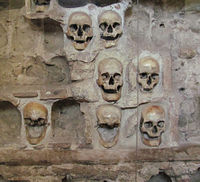Skull Tower
| Skull Tower | |
|---|---|

Detail of a tower wall
|
|
| Location | Niš, Serbia |
| Coordinates | 43°18′44″N 21°55′26″E / 43.3122°N 21.9238°ECoordinates: 43°18′44″N 21°55′26″E / 43.3122°N 21.9238°E |
| Built | 1809 |
| Visitors | 30,000–50,000 (in 2009) |
Skull Tower (Serbian: Ћеле Кула, Ćele kula, pronounced [tɕel̩e kula]) is a stone structure embedded with human skulls located in Niš, Serbia. It was constructed following the Battle of Čegar of May 1809, during the First Serbian Uprising. Serbian rebels under the command of Stevan Sinđelić were attacked by the Ottomans on Čegar Hill, near Niš. Knowing that he and his fighters would be impaled if captured, Sinđelić detonated a powder magazine within the rebel entrenchment, killing himself, his fellow rebels and the encroaching Ottoman soldiers. Vizier Hurshid Pasha ordered that a tower be made from the skulls of the fallen rebels. The tower is 4.5 metres (15 ft) high, and originally contained 952 skulls embedded on four sides in 14 rows.
Following the Ottoman withdrawal from Niš in 1878, the tower was roofed over, and in 1892 a chapel was built around it. In 1937, the chapel was renovated. A bust of Sinđelić was added the following year. In 1948, Skull Tower and the chapel enclosing it were declared Cultural Monuments of Exceptional Importance and came under the protection of the Socialist Republic of Serbia. Further renovation of the chapel occurred again in 1989. As of 2013, 54 skulls remain on the tower. The one that is said to belong to Sinđelić is enclosed in a glass container. Seen as a symbol of independence by Serbs, the tower is mentioned in the writings of French Romantic poet Alphonse de Lamartine and English travel writer Alexander William Kinglake. In the two centuries since its construction, it has become a popular tourist attraction, visited by between 30,000 and 50,000 people annually.
...
Wikipedia

